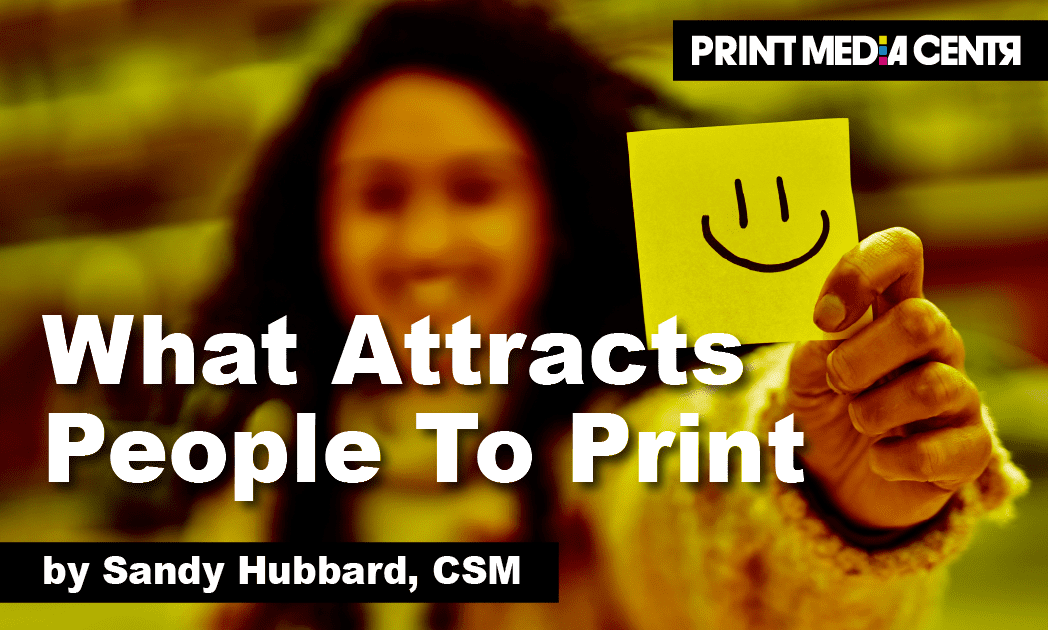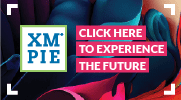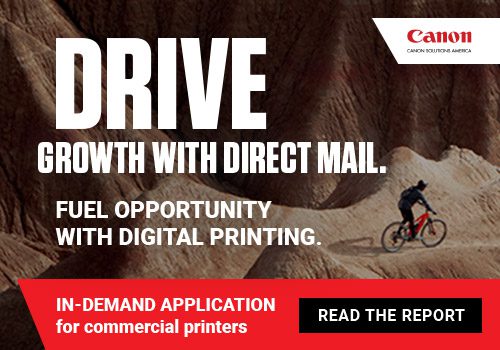
How do you find out what really attracts people to print? As a marketing strategist, I recommend research and data mixed with in-the-moment feedback. Research and data are great, but they’re based on what has already happened. Surveys are fine, but they may give overly positive results. Nothing beats testing a supposition with real people, in real time. Here are some ways to find out what draws people to print so you can create fabulous marketing campaigns and help print shine.
RESEARCH AND DATA
Before you get too vested in your ideas for print or marketing campaigns, definitely do your research. See what trends are coming and what has passed.
Use AI to gather data that will inform your suppositions. Arrange your research in different ways and test it against things like seasonality, audience characteristics, delivery medium, design choices, and so on.
Once you have your concepts dialed in, think about using a survey or poll to get current feedback from your target group.
PROS AND CONS OF SURVEYS
I’ve talked about the importance of surveying customers and prospects to see what they are attracted to and what they prefer. Their responses give a hint to what will draw people to our future print and marketing campaigns.
One of the key advantages of a survey is that it is current data. The mood and preferences of buyers change over time as younger people enter the industry and as people’s buying habits change. The immediacy of survey results can be very helpful in shaping and sharpening your print and marketing programs.
However (and here’s the disadvantage) there is bias in surveys. Not only is there bias in how surveys are worded – no matter how hard we try to make them impartial – but there’s also a skew in how people respond. People tend to answer how they think they “should” – either to please us or to make themselves more idealized. In addition, people use their memories – which can be unreliable – to form the basis for their answers.
I believe surveys are useful, but they shouldn’t be the only (or best) way to determine what draws people to print.
How can we get closer to the truth about what attracts people to print?
It takes creativity, persistence, and a willingness to get out there with the people.
REAL-TIME FEEDBACK
The closer we can get to real-time feedback without bias or someone trying to influence the outcome, the better data we can get.
It may sound obvious, but we have to get print in the hands of the people if we want to find out what they are drawn to.
Here are 3 tips on how to gather “in-the-moment feedback.”
1. Set up places where you can see people’s spontaneous reactions to your marketing materials. Unlike a conference room meeting with a prospect where you pass around your samples, find real-life scenarios where people don’t feel like they’re on the spot or have to be polite.
2. Make notes on what this audience is drawn to, where their touch lingers on the printed page, their mood and facial expressions, and the moment when they make a decision to pick up something and look more closely.
3. Be sure to note when people pick something up but put it back down decisively. This can show that the piece didn’t deliver on what the appearance promised.
Here’s an example of the type of feedback I gained by seeking real-time feedback.
My “in-the-moment feedback” took place every other year at our regional trade show. I had a double booth with a U-shaped table. On it were all the issues of my magazine printed since the last show – 24 stacks. As people walked around the tables, they would pick up certain issues, evaluate them, drop them in their bags, or put them back on the stack.
Here’s what I found, and I hope this helps you in crafting your own testing.
* Recency is very important. People will pick up the most current version of something, even if the older versions are cooler.
* People trust the opinions of others. Interestingly, people visiting my booth were drawn to the stacks of magazines that had the least number of remaining magazines in them. This indicated that other people found them worthy of being picked up and kept. It also triggered the scarcity/FOMO response. If you are doing one-to-one marketing, find a way to show authority and demonstrate that other people prefer you over your competition.
* Humans like photos of people. Good photography matters. If there’s a group photo, use captions. Make sure faces are clear and that facial expressions are neutral or positive. I would avoid AI images of people. They can be really funky, at least for now.
* Design is important. Even people who aren’t printers and designers are suckers for good design. In the split second when someone is deciding whether to pick something up, an eye-catching design can tip the scales in your favor.
* We tend to linger over things that are different – and done well. They like clever (and accurate) crossovers – like an image that spans multiple surfaces in a roll-folded mailer, for example. They like spot gloss and soft touch finishes, and will glide their hands across the page. They like glitter and glitz – but they also love a moody high-contrast art photo printed in black and white. That’s why we test to see what pulls people in.
* People like to be satisfied when engaging with the piece. They don’t want to be frustrated. You can create immediate appeal by making the piece more user-friendly. A great example is a perfect bound book that lays flat versus having that tight spine that wants to snap closed.
* White space attracts. Never underestimate the power of white space in your printed material. Out of 24 magazines I showed at my booth space, Popular Issues had one gorgeous, dramatic image, beautiful typography with an intriguing headline, and lots of white space. I think in our chaotic world, people are drawn to print that is simple and beautiful. It’s worth testing, right?
* The heft of the piece sends a powerful signal of credibility when the piece is picked up. For my magazine, I had to keep the total weight under a certain threshold to get my mailing discounts. Sometimes I printed on a 60-pound uncoated book, nice and toothy, and other times I printed on a lighter paper that was calendared. People preferred the heavier issues.
* Finally, there’s color. People love color. Fresh colors catch the eye. Pleasing color prompts people to look closer. Exciting color lures people to look at it again. This is so important because I see stale color combinations that date the piece before it even makes it onto the press. Why do this? Why kill your campaign before it even gets off the ground? Research color trends and hire professional designers. Color is paramount.
To wrap things up, if you want to find out what draws people to print…….
==> Do research using current, reliable information.
==> Gather data that can be scrutinized in various ways.
==> Conduct surveys that are as unbiased as possible.
==> Document hands-on feedback conducted with real people in real-time.
As you do your own research into what draws people to print, please let me know what you find. It’s fascinating to see our customers evolving in their preferences, and I love seeing printers and marketers being creative with the insight they gather.
Print is naturally attractive, so let’s help it do what it does best!
##
Check out last month’s post: How to Attend drupa 2024 Without Leaving Your Desk
 Sandy Hubbard is a Marketing Strategist and Advisor specializing in Print, Media, and B2B Tech. She helps print companies leverage their marketing to stand above the crowd. She founded the #HelpPrintThrive campaign to elevate the reputation of print and celebrate it with people outside our industry. Sandy is also the host of #PrintChat, a weekly global gathering of the industry’s most influential thinkers and leaders. A proud member of Girls Who Print, Sandy was the 2022 recipient of the coveted Girlie Award. Connect with Sandy on LinkedIn.
Sandy Hubbard is a Marketing Strategist and Advisor specializing in Print, Media, and B2B Tech. She helps print companies leverage their marketing to stand above the crowd. She founded the #HelpPrintThrive campaign to elevate the reputation of print and celebrate it with people outside our industry. Sandy is also the host of #PrintChat, a weekly global gathering of the industry’s most influential thinkers and leaders. A proud member of Girls Who Print, Sandy was the 2022 recipient of the coveted Girlie Award. Connect with Sandy on LinkedIn.










